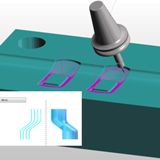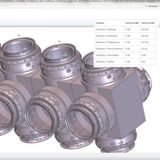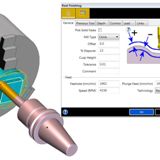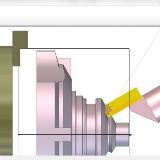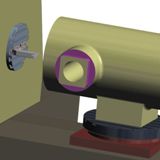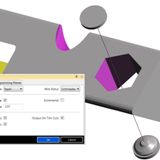Latest EDGECAM Loads Models 20 Times Faster
The new EDGECAM 2016 R2 offers significant time savings while loading solid model part files. During trials, the files loaded around 20 times faster, because less time is taken opening files, due to ‘tessellation.’EDGECAM Product Manager Simon Mee says: “This latest release of EDGECAM breaks the model down into triangles, which are then stored in such a way that they can be read back much faster than before.”
The new release is fully 64bit, improving access to memory. In the past, although EDGECAM’s machining engine and machine simulator have been 64bit, the overall package was 32bit. “This restricted large part files, but now EDGECAM is completely 64bit, it has the ability to store larger, and more, solid parts and toolpaths. Also, this speeds up toolpath transfer into 64bit memory.”
Full support is provided in a new module, for rotary heads typically found on Trevisan type machine tools, common to the oil and gas industry where very large components require a turning operation provided by the rotating head. The component remains stationary on the rotary table, with the secondary spindle being used to turn profiles and bores.
Support for Nutated Head on mill turn machines using Fanuc, Siemens and Heidenhain controllers is introduced into EDGECAM’s machine tool configurations.
Improvements have been made to machine configuration when simulating lathes with slanting turrets. “In the past, simulation showed this type of lathe as having the upper and lower turrets in line, but EDGECAM 2016 R2 displays slanting turrets in their true position.”
Turning, milling and wire EDM functions all benefit from numerous enhancements, including three for turners in the area of grooving. Improvements to the rough grooving cycle have done away with the need to manually add radius compensation, as the cycle now incorporates that functionality.
“The cycle now automatically detects a small radius or chamfer on a groove feature, and removes surplus cuts where applicable. “This not only saves cycle time, but also alleviates the need to manually check for wasted cuts.” The rough groove cycle also offers a new Intermediate Cuts function for determining the number of extra cuts required to successfully machine across a large chamfer or radius on a groove feature.
EDGECAM 2016 R2 continues to evolve its EWS product by importing 3D IGES wireframe files. Once the files have been loaded they can be turned into solid models with existing EWS tools such as Sketch Plane and Ruled Surface.
And three enhancements are aimed specifically at Wire EDM users. Firstly, new output options for each controller family have been added to the Machine Configuration settings – and the Makmino technology database has been updated to support additional machines and controllers.
Secondly, the Move command now supports rotary axis positioning, meaning users can choose not only a linear value, but also an angular co-ordinate. And thirdly, the Wire Ribbon Interface now has a ‘Translate’ command, giving the ability to globally move either single or multiple CAM instructions. “The command works in the same way as that in the mill and turning environments where ‘from’ and ‘to’ group the translated CAM instructions,” says Simon Mee.
Improved functionality to both mill/turn and milling profiling include a refined algorithm which generates less code while maintaining accuracy. “This is clearly seen when a user picks solid edges or loops from a solid model. The code is now converted to line/arcs if possible, dramatically reducing the amount of NC output.”
‘Corner control’ is now available when Compensation is set to Geometry. In previous versions of EDGECAM, the ability to break the corner was only supported when Compensation was set to Centre-Line.
And a further enhancement has removed ‘rollovers,’ which could happen when the cycle was set to Pick Solid Faces. This improvement will be applied automatically when the toolpath is regenerated in EDGECAM 2016 R2.
The new Editable Manual Turn feature means users can now alter a turned profile feature by simply checking an ‘edit’ command.
The Advanced 5-Axis Cycle benefits from seven new aspects, each one aimed at either offering new toolpath functionality, or improving existing ways of working. Focusing on the ‘Multi blade machining’ module, additional Collision Check options have been added, along with the introduction of a specific fillet finishing option commonly found on impellor components. The Roughing tab now includes the ability to mirror a 5-axis toolpath, which not only creates a mirror image by reflecting it symmetrically, but also alleviates the need to add extra transformation CAM instructions.
Port machining is given two enhancements. The cycle now uses Automatic Spine, where, by default, it checks the spine position in relation to the machining surface. “If it’s too close, the toolpath is automatically trimmed back,” says Simon Mee. “In previous versions the toolpath would not have been created. Also, an ‘Edge Rolling’ checkbox has been added to the port machining option which extends the toolpath as it enters the port.”
When using swarf machining in the 5-axis cycle, users will find a new parameter in the Utility tab: Maximum Angle Step For Rotation Axis limits the rotation angle of the machine head, as some machine controls struggle to compensate for large rotation angles.
A new pattern type – Flowline – has been added to the advanced 5-axis cycle. It creates a toolpath aligned to either the U or V direction of the machining surface. “The user can determine the toolpath’s style, choosing either ‘along’ or ‘around.’ As only a single face is required, calculation is extremely fast.” A typical application for Flowline is where a specific surface texture, or grain, is required.
Colour is now taken into account on the Filter Entity Type command. “This means users have extra control as they can identify all entities, including a solid feature, by their colour.
While using any of EDGECAM’s probing cycles entities, including linear and circular edges, vertices and circular faces, can now be picked directly from a solid model, and because they are associative to the model, the toolpath automatically updates after a design change.
A number of new and improved display enhancements give a greater level of control in EDGECAM 2016 R2. Machine Display buttons have been added to the Heads Up Display control, for toggling individual elements of a machine tool graphic. A ‘comment field’ has been added to all CAM cycles for outputting general information about a specific cycle, helping programmers communicate more easily. And, based on customer feedback, the new Setup Browser has replaced the Component Setup Window. While retaining all previous functionality, it adds the ability to dock and undock the display. The browser can be displayed on multiple tabs, but can also be hidden, if required.
EDGECAM 2016 R2 continues to evolve CAM cycle dialogs by adding images and context-sensitive help to more commands, specifically Plunge Roughing, Project Toolpath, Rest Finishing and Project Boundary Collapse.. “To use an old phrase, ‘A picture paints a thousand words,’ says Simon Mee. “This new functionality helps users to quickly understand exactly what the function does, reducing their learning curve.”











